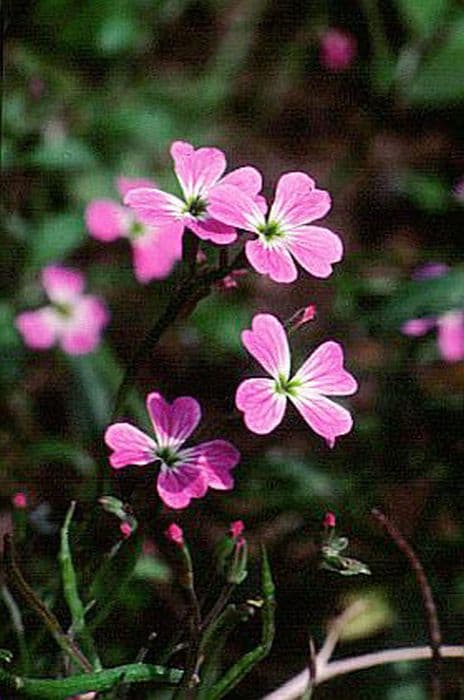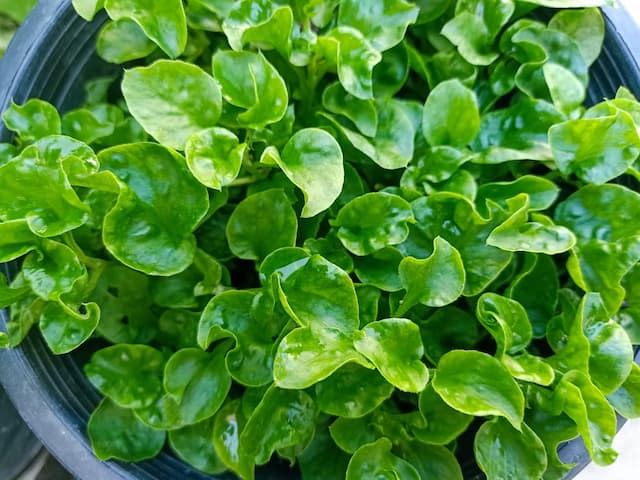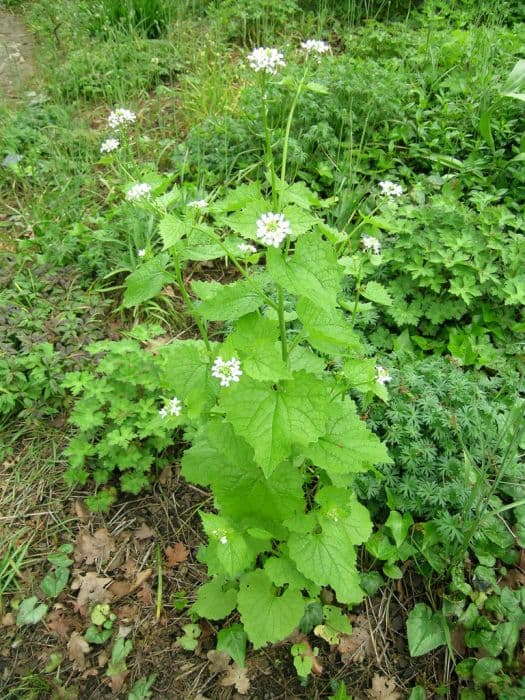Erysimum cheiri 'Sunset Apricot' (Sunset Series)

ABOUT
Erysimum cheiri 'Sunset Apricot,' commonly known as wallflower, is a perennial plant known for its vibrant coloration and enchanting fragrance. The plant boasts a flush of dense, richly colored flowers with a captivating apricot hue that fades into a soft, delicate blend of sunset shades. These blossoms are small, yet abundant, growing in clusters that form a striking display of warm tones, ranging from golden yellow to orange, and even displaying hints of pink. The foliage of the wallflower is also an attractive feature, providing a lush background of lance-shaped, dark green leaves that complement the luminous quality of the flowers. The leaves are often narrow and may have a slightly serrated edge, giving them a textured appearance. This rich greenery creates a beautiful contrast against the bright apricot-colored blossoms, heightening their visual impact. Wallflowers are known for their extended blooming period and can flower from early spring through to late spring or early summer, depending on local climate conditions. Their sweet and spicy aroma is most pronounced on warm, sunny days, making them a popular choice for gardens where their fragrance can be enjoyed. Overall, the Erysimum cheiri 'Sunset Apricot' presents a stunning visual presentation with its delightful range of colors and desirable fragrance, making it a standout choice for creating a bold and beautiful garden display.
About this plant
 Names
NamesFamily
Brassicaceae.
Synonyms
Sunset Apricot Wallflower, Sunset Apricot Erysimum.
Common names
Erysimum cheiranthoides, Cheiranthus cheiri, Erysimum cheiri
 Toxicity
ToxicityTo humans
Wallflower is not typically known for being highly toxic to humans. However, like many ornamental plants, it may cause mild digestive upset if ingested in large quantities, and it is always best to exercise caution and avoid ingesting parts of ornamental plants. There is no well-documented case of severe poisoning from this plant, but it is still advisable to keep it out of the reach of children who might be tempted to eat it. The general lack of significant toxins in Wallflower means that symptoms of poisoning are unlikely to be severe but could include nausea, vomiting, or diarrhea if it is consumed.
To pets
Wallflower is not commonly known as a toxic plant to pets, such as cats and dogs. However, it may cause mild gastrointestinal upset if ingested. Pets may experience symptoms such as vomiting or diarrhea if they consume parts of the Wallflower. As with humans, toxicity is generally low, and serious complications are not common, but it is still wise to prevent pets from ingesting the plant to avoid any potential discomfort.
 Characteristics
CharacteristicsLife cycle
Biennials
Foliage type
Evergreen
Color of leaves
Green
Flower color
Apricot
Height
18 inches (45 cm)
Spread
18 inches (45 cm)
Plant type
Herb
Hardiness zones
7
Native area
Mediterranean
Benefits
 General Benefits
General Benefits- Attracts Pollinators: Erysimum cheiri 'Sunset Apricot' is known for attracting bees and butterflies, which are essential for pollination and the health of the ecosystem.
- Colorful Display: The plant produces vibrant apricot to orange flowers that add a splash of color to gardens and landscapes.
- Extended Blooming: Its long blooming period, from early spring to summer, provides visual interest for a significant portion of the year.
- Drought Tolerance: Once established, it has good drought tolerance, making it suitable for regions with water scarcity or for gardeners looking for low-water plants.
- Easy to Grow: This variety is generally easy to grow and can thrive in a range of soil types, provided they are well-draining.
- Versatile Use: The plant is suitable for borders, rock gardens, and containers, offering flexibility in landscaping and garden design.
- Frost Hardy: It can survive in colder temperatures, making it suitable for a variety of climates and extending its growing range.
- Low Maintenance: The plant requires minimal care, making it a good choice for both novice and experienced gardeners.
- Perennial Growth: Being a perennial, it returns year after year, reducing the need for replanting and providing a long-term garden solution.
- Cut Flowers: The flowers from Erysimum cheiri 'Sunset Apricot' can be used for cut flower arrangements, bringing the beauty of the garden indoors.
 Medical Properties
Medical PropertiesThis plant is not used for medical purposes.
 Air-purifying Qualities
Air-purifying QualitiesThis plant is not specifically known for air purifying qualities.
 Other Uses
Other Uses- Photography backdrop: The vibrant apricot blooms of Erysimum cheiri can serve as a striking background for close-up photography or portraits.
- Companion planting: It can be used in a garden to attract pollinators, which can benefit nearby vegetable crops or fruit-bearing plants.
- Dye source: The petals of the flower may be used to create a natural dye for textiles or art projects.
- Edible decorations: The flowers of the plant are edible and can be used to garnish salads or decorate cakes.
- Garden borders: Wallflower plants are ideal for creating colorful borders along walkways or garden beds.
- Artistic inspiration: The Sunset Apricot's hues can inspire artists for paintings, fabric design, or color schemes.
- Floral arrangements: Wallflowers can be cut and included in bouquets or indoor flower arrangements for their color and mild fragrance.
- Education: The plant can be used in schools or educational programs to teach children about plant lifecycles and gardening.
- Culinary infusion: The flowers can be infused in syrups or vinegars to add subtle flavors and a hint of color to gourmet dishes.
- Botanical studies: Erysimum cheiri can be a subject for botanical study, demonstrating plant adaptation and survival in wall crevices or similar environments.
Interesting Facts
 Feng Shui
Feng ShuiThe Wallflower is not used in Feng Shui practice.
 Zodiac Sign Compitability
Zodiac Sign CompitabilityThe Wallflower is not used in astrology practice.
 Plant Symbolism
Plant Symbolism- Optimism: The vibrant apricot color of 'Sunset Apricot' Wallflower symbolizes a sense of positivity and the anticipation of good things to come, representing an optimistic outlook on life.
- Endurance: Wallflowers are known for their hardiness and ability to thrive in challenging conditions, making them a symbol of endurance and resilience.
- Faithfulness: Historically, wallflowers have been associated with faithfulness in adversity, often growing out of crevices in walls where other plants would not survive.
- Adversity: The wallflower's growth in tough places also symbolizes overcoming adversity and the ability to succeed despite obstacles.
- Friendship: Wallflowers are also occasionally seen as symbols of lasting friendship, possibly due to their long-lasting blooms and reliability.
 Water
WaterWallflowers, including 'Sunset Apricot' from the Sunset Series, prefer to be kept evenly moist but not waterlogged. Generally, water these plants with about 1 inch of water per week, which translates to approximately 0.623 gallons per square foot of soil area. During hot, dry spells, additional watering may be required to maintain consistent soil moisture. Always check the top inch of soil before watering; if it feels dry, it's time to water. Water the plant at the base to avoid wetting the foliage which can lead to fungal diseases. It’s better to water deeply and less frequently to encourage deep root growth.
 Light
LightWallflowers such as 'Sunset Apricot' perform best in full sun, which means they should receive at least 6 to 8 hours of direct sunlight daily. An ideal spot would be one that gets plenty of morning sun and some afternoon shade, particularly in hotter climates, to protect the plants from the intense late-day sun. Avoid deep shade locations as this can lead to poor flowering and lanky growth.
 Temperature
TemperatureWallflowers, like 'Sunset Apricot,' thrive in a wide range of temperatures but prefer cooler conditions. They can survive in temperatures as low as 20 degrees Fahrenheit but will stop growing once temperatures dip below this. The ideal temperature range for these plants is between 55 and 75 degrees Fahrenheit. They can tolerate temperatures up to about 85 degrees Fahrenheit, but prolonged heat can be detrimental to their health and blooming.
 Pruning
PruningPruning 'Sunset Apricot' wallflowers encourages bushier growth and more blooms. Prune lightly throughout the growing season to remove spent flowers (deadheading) and any leggy or damaged stems. The best time to prune for shaping is immediately after the plant has finished its main spring bloom, typically in early summer. Pruning more than one-third of the plant at a time can cause stress, so it's important to prune moderately.
 Cleaning
CleaningAs needed
 Soil
SoilWallflowers, such as 'Sunset Apricot', thrive in well-draining soil with a neutral to slightly alkaline pH range of 7.0 to 7.5. A mix of garden soil, compost, and gritty material like perlite or sand is ideal to ensure adequate drainage and fertility.
 Repotting
RepottingWallflowers typically do not require frequent repotting; doing so every 2 to 3 years is sufficient. This plant is often grown as a biennial, so repotting may not be necessary if it's replanted periodically.
 Humidity & Misting
Humidity & MistingWallflowers prefer normal outdoor humidity levels and do not require any special humidity adjustments. They can tolerate a wide range of conditions and do well without high humidity environments.
 Suitable locations
Suitable locationsIndoor
Place in bright indirect light and keep soil moderately dry.
Outdoor
Choose a sunny spot with well-drained soil and space 12 inches apart.
Hardiness zone
7-10 USDA
 Life cycle
Life cycleErysimum cheiri 'Sunset Apricot', commonly known as the 'Sunset Apricot' wallflower, begins its life cycle as a seed which germinates in well-drained soil under cool conditions, needing light to initiate growth. Seedlings emerge and establish a rosette of leaves at the ground level. As the plant matures, it develops a sturdy stem and an elaborate root system. The 'Sunset Apricot' wallflower then produces vibrant apricot-colored flowers in spring to early summer, attracting pollinators and completing the reproductive stage by setting seeds. After flowering, the plant may experience a period of dormancy, especially in hotter climates. The wallflower is often grown as a biennial, completing its life cycle in two years, though it can perform as a short-lived perennial in some conditions.
 Propogation
PropogationPropogation time
Spring to Early Summer
Erysimum cheiri 'Sunset Apricot', commonly known as Wallflower, is typically propagated through seeds. The best time to sow Wallflower seeds is during late spring to early summer. You want to start by sowing the seeds thinly into well-drained, fertile soil in a sunny location, preferably in a seedbed. Cover the seeds lightly with a fine layer of soil and water gently. Germination usually occurs in 14 to 21 days at temperatures between 65°F to 70°F (approximately 18°C to 21°C). Seedlings can then be thinned out and eventually transplanted to their final flowering positions in the garden during the autumn. This method allows for a large number of new plants to be raised relatively easily.






![Wallflower [Winter Orchid]](/_next/image?url=https%3A%2F%2Fplants-admin.emdemapps.com%2Fimages%2Fplants%2F%2Fimages%2F604b62b20ab9a.png&w=640&q=75)


